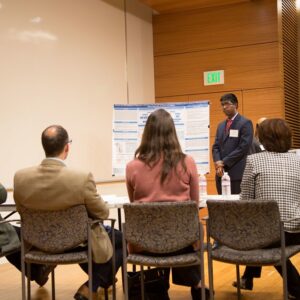This story was originally published in the Spring 2012 issue of Harker Quarterly
Harker’s upper school was recently selected to be the site of a study, funded by the Centers for Disease Control and Prevention (CDC), on how influenza and other diseases are transmitted from one person to another.
Headed by Dr. Marcel Salathé, who leads a group of researchers based at Penn State, the Harker Influenza Project was kicked off in January and is being helped by several teams of Harker students, each working on a project that will further the goal of discovering how disease spreads. On Jan. 24, March 2 and March 13, those taking part in the project wore motes (small electronic tracking devices worn around the neck) that recorded data on where they went and who they interacted with during the day. Whenever one mote wearer came within close enough proximity with another, the motes would record one another’s number, as well as that of the stationary motes that were placed in every room on campus.
Salathé previously conducted research on the upper school campus during the 2009-10 school year. His findings were published in the prestigious “Proceedings of the National Academy of Sciences,” and he received a $1.4 million grant from the CDC to continue his research. Because the previous project enjoyed a 95 percent participation rate, Salathé again opted to conduct research at Harker. This time, he and his team have help from several specially selected Harker juniors, who are leading the project groups.
One of the student projects, led by Michael Cheng, is the development of an application for smart phones that collects data on a person’s movements using a phone’s GPS capabilities. “Once started, the app will get a GPS reading every time the user moves a certain distance, which it will store along with a time stamp,” Cheng said. The goal of the application is to build upon the information recorded by the motes. “When the user has an Internet connection, the app will send the phone ID, name and location to the student server,” he said. The students have been helped during this project by Harker parent Somnath Banerjee (Nila, grade 10), who provided advice when the app was being planned and will be available for assistance when the students encounter a problem in testing.
Suchita Nety is heading up two teams responsible for finding out how environmental factors contribute to the spread of disease. One team, led by Ilsa Zhang, is researching how airflow can affect influenza outbreaks by examining carbon dioxide levels in rooms on campus.
“The CO2 team is gathering data using sensors which store data on CO2 levels, humidity and temperature, as well as examining air samples for microbes,” Nety said. “This data will reveal how the ventilation in a room, along with humidity and temperature, affects the number of airborne particles suspended in the air, as well as the likelihood of airborne transmission.”
Another team is examining surfaces on the upper school campuses for bacteria to gain insight on how disease can spread via contact with tables and countertops. “I really looked forward to the hands-on laboratory experience of actually swabbing the tables and visually seeing the bacteria that will be collected,” said chief researcher Andrew Luo. The team is swabbing surfaces and using Petri dishes to view the bacteria found on the various surfaces around campus.
Indulaxmi Seeni’s team is comparing data recorded by motes to the information received through surveys done by the mote wearers. “Our goal is to determine by how much the two differ and to find a way to interpret the data most accurately,” Seeni said. Her team will be looking at the data from several different angles, such as whether or not longer interactions are remembered more accurately and whether participants better remember people they see more often. The team will be collecting data from surveys during March and comparing it with the data sets received from the motes.
The final student research team will confirm the findings of Salathé’s previous project, “namely, to support the map of flu transmission he’d created using motes with actual evidence,” said lead investigator Victoria Lin. Participants have the option of volunteering to have their nasal areas and throats swabbed if they report a temperature of 100 or higher. These samples are sent to researchers at Stanford and the University of Pittsburgh for genome sequencing. This will confirm if the same flu virus is spreading or if a new one has been introduced. “We’re also assessing the accuracy of tests known as rapid diagnostics tests, which can give a positive or negative for presence of the flu within 10 minutes, often less,” Lin said.
Dr. Vicki Barclay, one of the Penn State researchers, was glad to see so many students wearing motes. “It’s good to see that we have so many people participating again,” she said.
Lin, meanwhile, was glad her team was able to gather enough interest in being swabbed. “People have been more receptive than I’d anticipated, given that there’s something of a gross factor with the swabbing,” she said. “We have more than 100 volunteers, which is definitely more than I’d expected, and [student council] and the project team have been great about helping pique interest in the project.”









